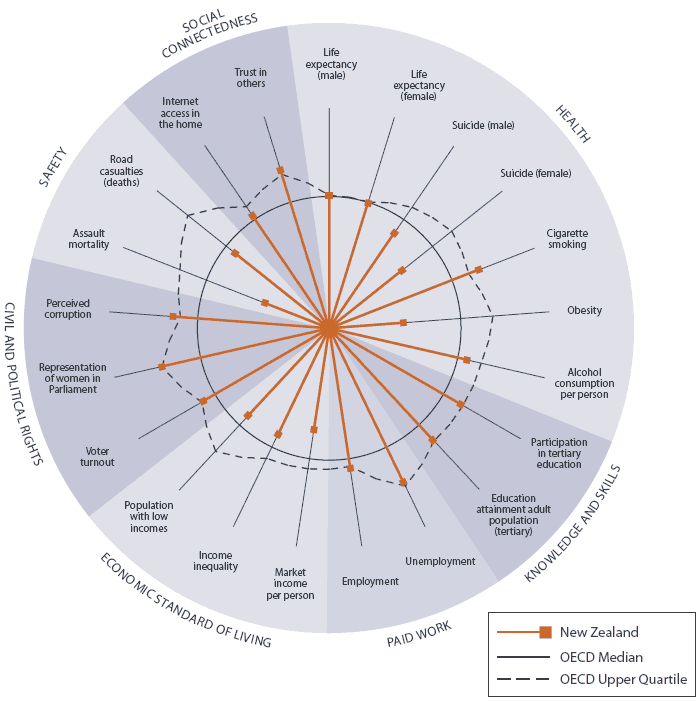New Zealand compared to OECD countries
New Zealand compares favourably to other OECD countries
For many indicators, New Zealand compares very well with other countries. New Zealand’s outcomes are better than, or similar to, the OECD median for around two-thirds of the 21 indicators for which there is internationally-comparable data.
New Zealand performs very well in the Civil and Political Rights domain. We are ranked first equal with Denmark and Sweden as the least corrupt of 30 OECD countries in 2008, and we are in the top third of those countries for the proportion of women in Parliament and for voter turnout.
Paid work is another area in which New Zealand performs strongly, with a relatively high employment rate, the seventh highest in 2008, and a relatively low unemployment rate, the 10th lowest (along with Australia), in 2008.
We also perform very well in the Social Connectedness area, with New Zealanders having a higher level of trust in others and a higher level of households with internet access than the OECD median.
In the area of Knowledge and Skills, New Zealand is above the OECD median for the proportion of adults who have a bachelor’s degree or higher, and for participation in tertiary education among 20–29 year olds. The proportion of New Zealand adults with prose and document literacy and numeracy skills in English at Level 3 or above is similar to the proportions in Australia and English-speaking Canada, and higher than the proportion in the United States.
In the Health domain, New Zealand’s results are mixed. Our life expectancy is similar to the OECD median, although there is a relatively narrow range of outcomes across the OECD for this indicator. New Zealand’s rates of cigarette smoking and alcohol consumption are slightly better than the OECD median. Among the countries that use actual measurements of obesity rather than self-reporting, our obesity rate is similar to those of Australia and the United Kingdom and lower than that of the United States. We have relatively high suicide death rates, particularly for youth.
New Zealand does not perform well in the Safety domain. Our road death rate was slightly higher than the OECD median in 2007, while data from 2003–2007 showed our homicide death rate was worse than the OECD median.
Our Economic Standard of Living results tend to be lower than those in many OECD countries. In 2004, New Zealand was near the middle of the OECD for population with low incomes and was higher than the OECD median for income inequality. In 2008, New Zealand was below the OECD median for market income per person.
Figure IC1 Social indicators in New Zealand, relative to the OECD

Interpreting "Social indicators in New Zealand relative to the OECD"
This figure shows New Zealand relative to the OECD for 21 social indicators. The circle  represents the OECD median for each indicator, and the spokes represents the OECD median for each indicator, and the spokes  represent New Zealand’s outcomes relative to the OECD median. The irregularly shaped line outside the OECD median circle represent New Zealand’s outcomes relative to the OECD median. The irregularly shaped line outside the OECD median circle  represents outcomes of the OECD upper quartile relative to the OECD median. Where a spoke falls inside the circle, outcomes in New Zealand are worse than the OECD median. Where the spoke falls outside the circle, outcomes in New Zealand are better than the OECD median. Where a spoke falls past the irregularly shaped line, New Zealand is in the top quarter of OECD outcomes.
For each indicator, the most recent data has been used where possible. Most of the data is for years between 2005 and 2008, but the population with low incomes and income inequality data is for 2004 and the assault mortality data is for 2003–2005. represents outcomes of the OECD upper quartile relative to the OECD median. Where a spoke falls inside the circle, outcomes in New Zealand are worse than the OECD median. Where the spoke falls outside the circle, outcomes in New Zealand are better than the OECD median. Where a spoke falls past the irregularly shaped line, New Zealand is in the top quarter of OECD outcomes.
For each indicator, the most recent data has been used where possible. Most of the data is for years between 2005 and 2008, but the population with low incomes and income inequality data is for 2004 and the assault mortality data is for 2003–2005.
SOME CAUTION IS REQUIRED WITH THIS DATA: international comparisons are difficult to interpret because of the different methods countries use to collect, classify and record social data. There were too few countries for adult literacy to include this indicator in the figure.
|